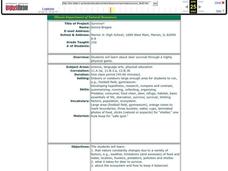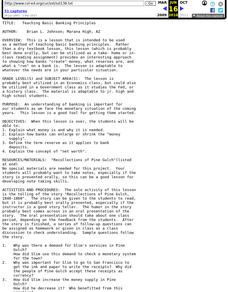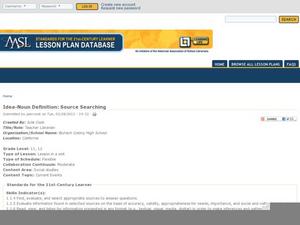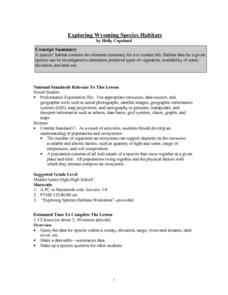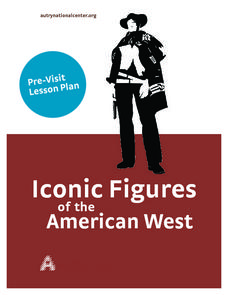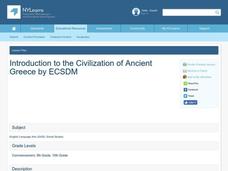Curated OER
Cyber Memory--Let's Hope Not
Sixth graders continue to read excerpts from "The Last Book in the Universe". In groups, they discuss any questions they have about the material. They research an endangered threatened species and make a plea to the rest of the class...
Curated OER
Survivor!
Students play a game in physical education class to examine how a deer survives. Using nature as a guide, they discover how it is constantly changing due to weather, food, water, pollution and predators. They discuss the characteristics...
Curated OER
Arranging Patriotic Music for Instruments
Students arrange a short piano composition for a group of four to six instruments of their choice. The musical arrangements should be then demonstrated and analyzed by the class as a unit study.
Curated OER
Cell Game
Make a prototype of a game based on cell biology. Researching game design and working in groups to create a game will activate knowledge of cell biology. The review task will help students learning as they test out the games and their...
Curated OER
Teaching Basic Banking Principles
Students listen to the story, "Recollections of Pine Gulch, 1840-1860" to determine how banks "create" money, what reserves are, and what a "run" on a bank is.
Curated OER
Teaching Basic Banking Principles
Students explore basic banking principles and the value of money as they probe into the lesson. The case of Gus Mahler is examined as students discover the money making dealings of the banking industry.
Curated OER
Illustrated Safety Contract
High schoolers create illustrated contracts that spell out chemistry lab safety rules. They create original drawings illustrating one of the safety rules published by Flinn Scientific.
Curated OER
Refining the Why? Turning Student Questions into Research
Middle schoolers have years of experience when it comes to how their bodies work. Surely they have some questions as well. Here is an opportunity for them to practice the scientific method in an attempt to answer some of those questions....
Curated OER
Comparing Mitosis with Meiosis
Life science learners view an online animated mini textbook comparing two types of cell division. Working in groups, they use a digital microscope to capture images of cells in different stages of mitosis and meiosis. Then they create an...
Foreign Policy Research Institute
Understanding China: The Prospects for Democracy in China
This document provides useful information for a unit on democracy in China. While it does not include detailed activities, it does have a list of democratic principles, and important facts about China that facilitate understanding of its...
Curated OER
Bits of Braille
Intended to build an understanding of Braille in a general education classroom. They read the book Helen Keller then write their names using a braille website. Many interesting web links are included. Could be used for a general or...
Curated OER
Idea-Noun Definition: Source Searching
A great idea for showing language arts pupils the universality of themes, even in the real world! Have class members choose an idea-noun (peace, justice, war, love, etc.) at the beginning of the year or semester. They complete weekly...
University of Colorado
Phases of Charon
Charon, the largest of Pluto's moons, was discovered in 1978. Lesson is a walk through of how to solve for the phases of Charon. It uses two different points on Pluto and takes into account the tilt of the pole, the rotational axis, and...
Curated OER
Exploring Wyoming Species Habitats
Students are introduced to the concept of species habitats and ranges. They introduced to ArcView GIS as a tool for mapping. Pupils use query data for species withina county, elevation, range, rivers and streams, land cover, and etc....
Curated OER
U.S. History: de Soto's Alternate Route
Eighth graders examine various maps associated with Hernando de Soto's expedition. By comparing their textbook maps with newer maps, they answer a battery of focus questions. Using Microsoft Word, 8th graders answer the questions...
Curated OER
Clash of Cultures: Comparing the 1920s and 1960s
Students compare the social, cltural and politicalp roblems of the 1920s with the 1960s.
Curated OER
Clash of Cultures: Comparing the 1920s and 1960s
Students identify the social, culturaland political problems of the 1920s and compare them to the problems of the 1960s. They research both eras and then make a presentation to the rest of the class.
Curated OER
Western-Genre Films
Students watch westerns and analyze them. They identify the plot, characters and the sounds in the film. They research icons of the American west and prepare a presentation. They share their presentation with the class.
Curated OER
Introduction to the Civilization of Ancient Greece
Students realize Greece's location in relation to the previously learned civilizations and learn the vocabulary needed for this unit of study. They use the interactive SMART board to locate places and learn necessary information of...
Curated OER
Preserving Our Barns
Students examine the different points of view when it comes to preserving barns. Using the internet, they work together to identify the risk involved in renovations and a barn in their local town that needs to be renovated. They create...
Curated OER
What to do Between AP Exams and Semester Finals
Trying to write your end-of-year exam while encouraging scholars to begin reviewing? Do both using this study-skills strategy, which has scholars writing their own test! Although this lesson is intended for AP classes, it is applicable...
Curated OER
Electronic Mapping
Students identify countries, oceans, and capitals by building an electronic map.
Curated OER
Message in a Bottle
Students acquire a pen pal in a foreign country and write letters at least twice a month throughout the year to exchange with them. At the end of the year, they write an essay that compares one important difference and one important...
Curated OER
In Congress Assembled: Continuity and Change in the Governing of the United States
Students interpret history using primary resources and secondary research. The Constitution is examined and changes are explained within the time period they were made.



